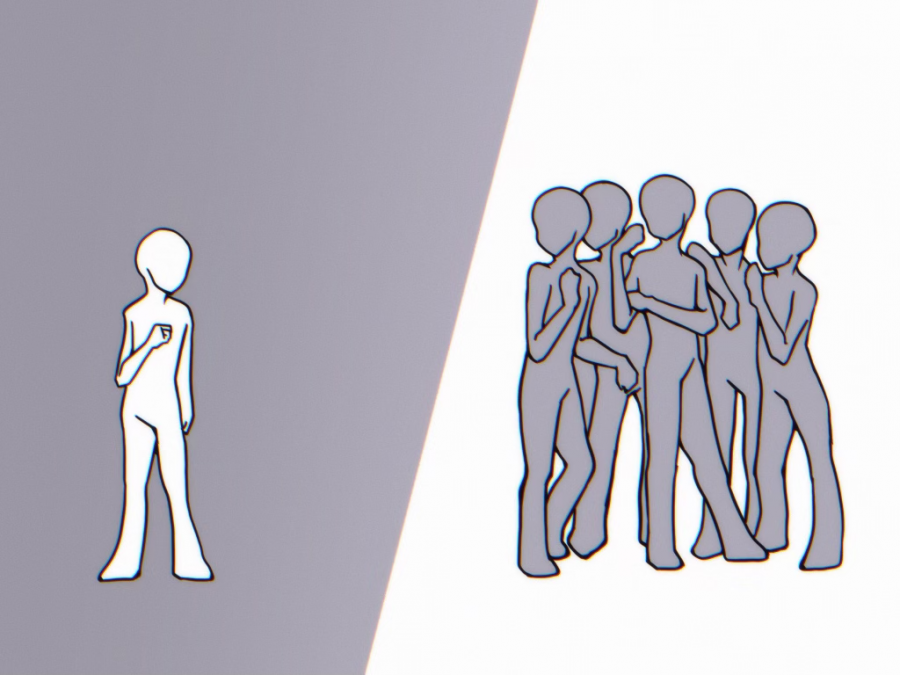Still Human
We must remain compassionate to those with all mental illnesses, even those we deem “dangerous.”
digital drawing by Vanessa Hong
The stigma those with Antisocial Personality Disorder face puts them in danger not only in their everyday lives but also in medical and judicial settings.
The words “psychopath” and “sociopath” are strewn throughout the media, from factual accounts of serial killers to the fictional world of crime shows. Recall Silence of the Lambs, No Country for Old Men, or Ted Bundy, and it is not long before those terms come to mind.
In the cultural eye, psychopaths and sociopaths connote violence.
It’s even the case in the justice system, where our image of dangerously manipulative, uncaring, and untreatable outliers suggests they are better left in prison.
Yet even though people with Antisocial Personality Disorder (ASPD)—the clinical term for what is colloquially known as psychopathy or sociopathy—do have a range of symptoms, such apathy, juvenile delinquency, and psychological manipulativeness, the majority of antisocial people live normal lives.
First, we must evaluate the cultural approach to language, especially medical language, and how that leads to a confusion of terms. And it starts by defining what isn’t psychopathy.
Many assume that introversion or dislike for social settings denotes “antisocial,” but clinically, “antisocial” refers to apathy, violence, callousness, and the other hallmarks of ASPD, while “asocial” is a more accurate term for introversion.
It is common to confuse psychopathy and psychosis as well. Psychosis primarily refers to those with auditory or visual hallucinations, while psychopathic individuals are primarily characterized by the Hare Psychopathy Checklist-Revised (PCL-R), otherwise known as the “psychopath checklist,” which rates every symptom on a scale of zero to two (zero indicating not present, one indicating partially present, and two indicating fully present).
While ASPD exists as a blanket term for those with antisocial behaviors, the word “psychopath” refers only to more extreme cases of ASPD. In this way, symptoms of ASPD like apathy, violence, or aggression exist on a spectrum, as the cutoff of the psychopathy diagnosis is from 25-30 and above, while generalized ASPD can exist below.
Nevertheless, damaging cultural stereotypes regarding ASPD persist. A meta-analysis on the stigma of personality disorders by Lindsay Sheehan, Katherine Nieweglowski, and Patrick Corrigan of the Illinois Institute of Technology sought an explanation.
Sheehan and her coworkers reviewed a 2013 psychology study on ASPD at Whitworth University by Amanda Tufts. The study showed that when symptoms of ASPD begin to show in childhood, those children are labeled as delinquents by teachers, parents, and peers, which leads to a cycle in which the child is refused access to therapy or resources. As a result, such children tend to believe themselves to be errant, increasing the likelihood of a future life of crime, which only further reinforces their negative self-image.
Sheehan, Nieweglowski, and Corrigan also referenced a 2013 study by Kathleen Wayland and Sean O’Brien that found that most court officials do not consider ASPD to be a mental illness at all. Wayland and O’Brien found that within the confines of the justice system, people with ASPD are unable to make a complete rehabilitation, and their diagnosis can affect sentencing and even the possibility of a death penalty.
While much of the stigma surrounding ASPD, along with many other personality disorders, comes from the media, the medical community itself is also part of the problem. There is a persistent, statistically unproven claim among psychologists of lack of treatability for those with ASPD, leading to the perception that they are uncontrollable and maniacal.
In a study done in 2018, scientists John Edens, John Petrila, and Shannon Kelley found that many of the crucial decisions made in courts rested on a narrative of people with ASPD being unlikely to change. Other studies have arrived the same conclusions.
An article written by Rasmus Rosenberg Larsen and published by Johns Hopkins University Press called Psychopathy Treatment and the Stigma of Yesterday’s Research calls this belief “clinical pessimism.” Larsen cites that one of the founders of contemporary psychopathy research, Hervey Cleckley, concluded that not much can be done to treat ASPD.
One study, done in 1992 by Marnie Rice, Grant Harris, and Catharine Cormier, concluded that attempting to remedy ASPD via traditional therapy only exacerbates antisocial behavior. However, this study has several problems other scientists, along with Larsen, found.
First, this study was unable to be replicated by the original scientists or the larger psychiatric community.
Second, and more importantly, the study was housed at a problematic treatment program at the Oak Ridge Social Therapy Unit in Ontario, Canada. Years after the study concluded, in 2000, a class lawsuit was raised against the unit and its doctors, and in May 2017, a Canadian judge ruled in favor of the plaintiffs, comparing the “treatment” to torture. The violent, antisocial behavior of the people with ASPD after the treatment makes sense given their reaction to trauma and pain.
Third, several other psychologists disagree with the 1992 study’s findings. In 2002, scientist Randall Salekin reviewed 42 treatment studies and came to the conclusion that this clinical pessimism has very little empirical evidence. He found that many of the perceptions of people with ASPD as “untreatable” stemmed not from a scientific or statistical basis, but from anecdotes. Later studies agreed with Selkin, and one even stated that diagnosed psychopaths “are now being denied treatment on the basis that they are either untreatable or that treatment might make them worse.” Preconceived notions like these can be what prevents people with ASPD from being admitted into treatment or rehabilitation groups in the first place.
While the effects of societal, medical, and the justice system’s stigma cannot justify many of the violent or aggressive actions that come from people with ASPD, it does shed light on many antisocial actions. A combination of the mental illness itself and the stigma that surrounds it leads to a cycle of criminal acts with no one, psychologist or judge, willing to help those with ASPD.
As one health writer states, “Having a mental health issue doesn’t absolve a person of responsibility for their actions, but it’s an important factor in understanding why some people behave the way they do. When stigma perpetuates the idea of a group of people as evil, positive change becomes even more difficult to achieve.”
However, as more studies reach the public eye, anti-stigma organizations have arisen, and new psychological research has also been set in motion. Particularly, recent neurological evidence suggests that ASPD is associated with specific brain abnormalities, a finding that may lead to significant changes in the criminal justice system, especially in sentencing and treatment.
Sheehan and her colleagues suggest anti-stigma interventions, along with more careful research into ASPD and the stigma surrounding it. However, while progress in the medical field is useful, we still must keep in mind that the impact of the cultural connections we make often fall behind psychological research. We must redefine the culture that perpetuates stigma, including reevaluating our language, media, and art. We must see people beyond the confines of their disorders.
Jon Ronson, a journalist who wrote The Psychopath Test, interviewed a businessman named Al Dunlap who he thought was a psychopath. Ronson said in his TED talk, “So whenever he [Al Dunlap] said anything to me that just seemed kind of non-psychopathic, I thought to myself, well I’m not going to put that in my book… I was desperate to define him by his maddest edges… He’s a gray area in a world that doesn’t like gray areas. But the gray areas are where you find the complexity. It’s where you find the humanity, and it’s where you find the truth.”

Aris Pastor is a senior at NASH. They are the event leader of interpretation for the North Allegheny Speech and Debate Team, and they have hopes for a future in both psychiatric research and law. They love reading, listening to Supreme Court podcasts, and thinking too hard about fictional characters. They will be going to Bowdoin College, majoring in government and legal studies, as well as psychology,...




Floren Lesley • Feb 2, 2023 at 9:45 pm
I just want to say thank you for putting your time, energy, and knowledge into this article. It’s quite rare to find someone, especially a person who’s working their way up in the psychology field, actually defend folks with ASPD. I’m a 4th year college student who’s majoring in Psychology. Having a class on Research Methods, I have to conduct a psychological study. I chose my topic to be mental health stigma, primarily how mass media feeds stereotypes into young adults.
I hope to figure out how to lessen this stigma, so that people with ASPD won’t feel dehumanized and hesitant to seek help.
Nessylea • Jun 5, 2022 at 5:07 am
I hope you don’t mind but I shared your article to Quora (multiple spaces) and Reddit.
This is one of the most impressive articles that I have seen in relation to Antisocial Personality Disorder.
You are amazing.